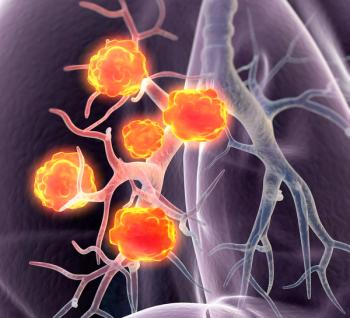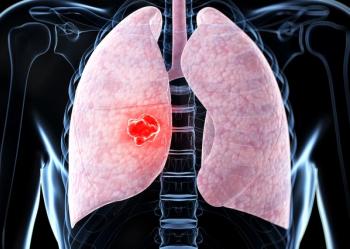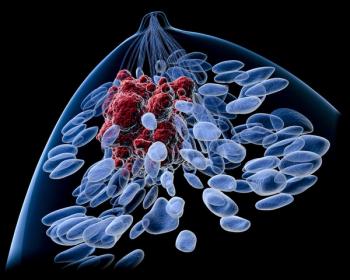
FDA Approves T-DXd in HER2-Low/Ultralow Breast Cancer

Results from the DESTINY-Breast06 trial led to the approval of T-DXd for patients with unresectable or metastatic HER2-low or HER2-ultralow breast cancer.
Trastuzumab deruxtecan (T-DXd; Enhertu) has been approved by the FDA for patients with unresectable or metastatic HER2-low or HER2-ultralow breast cancer who have previously been treated with at least 1 type of endocrine therapy in the metastatic setting, according to a press release from the agency.1
The approval was based on results from the
Results that were previously presented at the
Across all treatment arms of the HER2-low, ITT, and HER2-ultralow groups, the confirmed objective response rate was 56.5% vs 32.2%, 57.3% vs 31.2%, and 61.8% vs 26.3%.
Additional findings highlighted at the
“T-DXd works regardless of the [patient] subgroup, both in patients with high disease burden and low disease burden, and in patients who have rapid disease progression on first-line therapy and those who do not,” study investigator Aditya Bardia, MD, MPH, FASCO, stated in an interview with CancerNetwork® ahead of the approval. “In pretty much all the subgroups, T-DXd works.”
Bardia is a professor in the department of Medicine in the Division of Hematology/Oncology, a director of Translational Research Integration, and a member of Signal Transduction and Therapeutics at UCLA Health Jonsson Comprehensive Cancer Center.
Patients were randomly assigned to the T-DXd arm (n = 436) and received 5.4 mg/kg of treatment every 3 weeks or the chemotherapy arm (n = 430). The primary end point was PFS. Secondary end points included PFS in the ITT population, overall survival (OS) in the HER2-low group, and OS in the ITT population.
In the ITT population, the median patient age was 58.0 years in the T-DXd arm and 57.0 years in the chemotherapy arm, with 57.8% vs 59.8% having an ECOG performance status of 0, and 54.8% vs 54.4% having HER2-low disease. Additional characteristics included 29.4% vs 32.6% having primary endocrine resistance, 30.5% vs 30.7% having de-novo disease at diagnosis, and 86.2% vs 84.7% having visceral disease at baseline.
For patients receiving therapy in the adjuvant/neoadjuvant setting, treatments included endocrine therapy (63.1% vs 59.5%) and cytotoxic chemotherapy (52.3% vs 54.4%), which included a taxane (41.1% vs 41.2%) and an anthracycline (45.2% vs 47.9%) for patients in the T-DXd and chemotherapy arms, respectively.
At the data cutoff of March 18, 2024, there were 457 blinded independent central review PFS events for patients with HER2-low disease and 540 occurring in the ITT population. At the first interim OS analysis, there were 282 events for patients with HER2-low disease and 335 in the ITT population. This had a maturity of about 40%. The second and final interim OS analysis is set to be performed for patients with HER2-low at about 56% and about 74% maturity, respectively.
The median treatment duration was 11.0 months in the T-DXd arm and 5.6 months in the chemotherapy arm. Any-grade treatment-emergent adverse effects (TEAEs) occurred in 98.8% in the T-DXd arm vs 95.2% in the chemotherapy arm, with grade 3 or higher events in 40.6% vs 31.4%. Serious TEAEs were noted in 20.3% vs 16.1%, 14.3% vs 9.4% had TEAEs associated with discontinuation, 48.4% vs 38.4% had TEAEs associated with interruptions, and 24.7% vs 38.6% had TEAEs related to reductions. Of note, TEAEs leading to death occurred in 2.5% vs 1.4%, respectively.
The most common TEAE associated with treatment discontinuation was pneumonitis at 5.3% in the T-DXd arm and peripheral sensory neuropathy in the chemotherapy arm at 1.4%. The most common TEAE associated with dose reduction was nausea at 4.4% in the T-DXd arm and palmar-plantar erythrodysesthesia in 16.5% of the chemotherapy arm.
The
References
- Enhertu approved in the US as first HER2-directed therapy for patients with HER2-low or HER2-ultralow metastatic breast cancer following disease progression after one or more endocrine therapies. News release. FDA. January 27, 2024. Accessed January 27, 2024. https://tinyurl.com/5n8ab8sk
- Curigliano G, Hu X, Dent RA, et al. Trastuzumab deruxtecan (T-DXd) vs physician’s choice of chemotherapy (TPC) in patients (pts) with hormone receptor-positive (HR+), human epidermal growth factor receptor 2 (HER2)-low or HER2-ultralow metastatic breast cancer (mBC) with prior endocrine therapy (ET): primary results from DESTINY-Breast06 (DB-06). J Clin Oncol. 2024;42(suppl 17):LBA1000. doi:10.1200/JCO.2024.42.17_suppl.LBA1000
- Bardia A, Hu X, Dent R, et al. Efficacy and safety of trastuzumab deruxtecan (T-DXd) vs physician’s choice of chemotherapy (TPC) by pace of disease progression on prior endocrine-based therapy: additional analysis from DESTINY-Breast06. Presented at: San Antonio Breast Cancer Conference; December 10-13, 2024; San Antonio, TX. Abstract LB1-04.
- Enhertu granted Priority Review in the US for patients with HER2-low or HER2-ultralow metastatic breast cancer who have received at least one line of endocrine therapy. News release. AstraZeneca. October 1, 2024. Accessed October 1, 2024. https://tinyurl.com/bdh6vdad
Newsletter
Stay up to date on recent advances in the multidisciplinary approach to cancer.

















































































